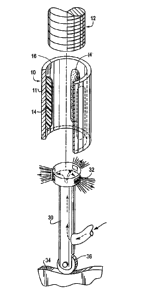Une partie des informations de ce site Web a été fournie par des sources externes. Le gouvernement du Canada n'assume aucune responsabilité concernant la précision, l'actualité ou la fiabilité des informations fournies par les sources externes. Les utilisateurs qui désirent employer cette information devraient consulter directement la source des informations. Le contenu fourni par les sources externes n'est pas assujetti aux exigences sur les langues officielles, la protection des renseignements personnels et l'accessibilité.
L'apparition de différences dans le texte et l'image des Revendications et de l'Abrégé dépend du moment auquel le document est publié. Les textes des Revendications et de l'Abrégé sont affichés :
| (12) Brevet: | (11) CA 2657299 |
|---|---|
| (54) Titre français: | ELEMENT DE RETENUE ET D'ALIGNEMENT D'ENSEMBLE DE FIXATION |
| (54) Titre anglais: | FASTENER ASSEMBLY RETENTION AND ALIGNMENT ELEMENT |
| Statut: | Octroyé |
| (51) Classification internationale des brevets (CIB): |
|
|---|---|
| (72) Inventeurs : |
|
| (73) Titulaires : |
|
| (71) Demandeurs : |
|
| (74) Agent: | FINLAYSON & SINGLEHURST |
| (74) Co-agent: | |
| (45) Délivré: | 2017-08-15 |
| (22) Date de dépôt: | 2009-03-06 |
| (41) Mise à la disponibilité du public: | 2009-09-17 |
| Requête d'examen: | 2014-02-28 |
| Licence disponible: | S.O. |
| (25) Langue des documents déposés: | Anglais |
| Traité de coopération en matière de brevets (PCT): | Non |
|---|
| (30) Données de priorité de la demande: | ||||||
|---|---|---|---|---|---|---|
|
Un ensemble de fixation comprend un élément de retenue et dalignement utilisé en association avec un premier composant qui possède une paroi cylindrique qui définit un alésage et un second composant qui possède un arbre allongé pour une insertion dans lalésage du premier composant. Lélément de retenue et dalignement comprend une pluralité de protubérances polymères allongées, possédant chacune (i) une base fixée à la paroi cylindrique du premier composant, (ii) une hauteur suffisante pour quensemble, les extrémités libres des protubérances définissent un passage qui crée un réglage avec serrage avec larbre du second composant, et (iii) une longueur suffisante pour maintenir larbre du second composant généralement colinéaire avec laxe de lalésage du premier composant.
A fastener assembly including a retention and alignment element used in combination with a first component having a cylindrical wall defining a bore and a second component having an elongated shaft for insertion into the bore of the first component. The retention and alignment element comprises a plurality of elongated polymeric protuberances, each having (i) a base fixed to the cylindrical wall of the first component, (ii) a height sufficient so that together the free ends of the protuberances define a passageway that creates an interference fit with the shaft of the second component, and (iii) a length sufficient to maintain the shaft of the second component generally collinear with the axis of the bore of the first component.
Note : Les revendications sont présentées dans la langue officielle dans laquelle elles ont été soumises.
Note : Les descriptions sont présentées dans la langue officielle dans laquelle elles ont été soumises.

Pour une meilleure compréhension de l'état de la demande ou brevet qui figure sur cette page, la rubrique Mise en garde , et les descriptions de Brevet , États administratifs , Taxes périodiques et Historique des paiements devraient être consultées.
| Titre | Date |
|---|---|
| Date de délivrance prévu | 2017-08-15 |
| (22) Dépôt | 2009-03-06 |
| (41) Mise à la disponibilité du public | 2009-09-17 |
| Requête d'examen | 2014-02-28 |
| (45) Délivré | 2017-08-15 |
Il n'y a pas d'historique d'abandonnement
Dernier paiement au montant de 624,00 $ a été reçu le 2024-02-20
Montants des taxes pour le maintien en état à venir
| Description | Date | Montant |
|---|---|---|
| Prochain paiement si taxe générale | 2025-03-06 | 624,00 $ |
| Prochain paiement si taxe applicable aux petites entités | 2025-03-06 | 253,00 $ |
Avis : Si le paiement en totalité n'a pas été reçu au plus tard à la date indiquée, une taxe supplémentaire peut être imposée, soit une des taxes suivantes :
Les taxes sur les brevets sont ajustées au 1er janvier de chaque année. Les montants ci-dessus sont les montants actuels s'ils sont reçus au plus tard le 31 décembre de l'année en cours.
Veuillez vous référer à la page web des
taxes sur les brevets
de l'OPIC pour voir tous les montants actuels des taxes.
Les titulaires actuels et antérieures au dossier sont affichés en ordre alphabétique.
| Titulaires actuels au dossier |
|---|
| NYLOK CORPORATION |
| Titulaires antérieures au dossier |
|---|
| SESSA, EUGENE |